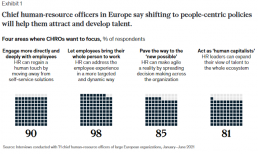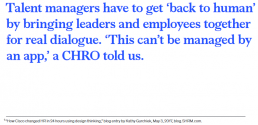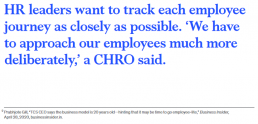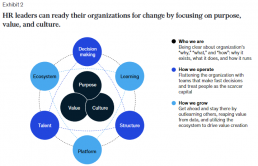‘Back to human’: Why HR leaders want to focus on people again
As we move through this Pandemic we need to continually adapt to change. One area of an organisation that will focus continually on adaptions, is that of the HR dept.
It will be vital for HR to be able to assess the capability of their organisation to act on strategic intent through their people. A good question to consider regarding ‘strategic alignment with people’ – Do they want to and are they able to?
Identifying matters, using qualitative and quantitative real time data, will determine any underpinning issues. Woking proactively with root causes enables the mood of the organisation to change positively and creates a culture to support and achieve business strategies.

Chief human-resource officers in Europe say a shift to employee-centric policies is long overdue. The pandemic is a big factor in their thinking, but process fatigue has been building for some time.
For years now, human-resource leaders have found themselves on a cost-efficiency treadmill that applies analytics and big data to existing HR operating models. Their departments have lived by a worthy but uninspiring mandate: to optimize labor costs, reinforce compliance using standardized measures, and support the adoption of technology beyond IT. Even in the areas of HR traditionally imbued with meaning and cultural significance—recruitment, and learning and development—the emphasis has been on productivity and how to measure it. For chief human-resource officers (CHROs), the question has now become whether processes have replaced the creativity and innovation they need to attract and develop talent, manage and reward performance, and optimize workforce strategy. This desire for more people-centric policies came through loud and clear during recent interviews we conducted with more than 70 CHROs at some of Europe’s largest organizations. The conversations were part of McKinsey’s research on how HR leaders can help to create a more dynamic talent and work model for the future. The vast majority of CHROs said they were eager to shift to a model we have come to call “back to human.” The COVID-19 pandemic—which accelerated employee demands on HR to meet physical and mental health needs, as well as intensified moral concerns about a company’s overall impact on society—lent urgency to their view that some core human element has been lost in all these technological advancements. The crisis also turned talk of creating more agile HR models into reality, as the C-suite looked to HR for both day-to-day crisis management and strategic thinking about workforces. CHROs say they want to keep that momentum going, particularly as employees register concerns about the future of hybrid work. This article is the first in a CHRO series we will expand to North America and Asia. Here we summarize insights gleaned from our interviews in four areas where CHROs want to implement more flexible, responsive policies: engaging more directly and deeply with employees, letting them bring their whole person to work, paving the way to the “new possible,” and acting as a human capitalist.HR’s role: From processes to people Mastering technology to improve standard HR processes and develop insights through advanced analytics will continue to give any HR leader the “right to play.” But to build organizational resilience and generate value, CHROs and their teams must connect these insights to the business in four ways (Exhibit 1).

Engage more directly and deeply with employees Many European CHROs discussed what they saw as an uncomfortable paradox: the opportunity to build personal relationships has been disrupted by certain strategies that HR teams have been promoting for some time. These strategies include remote performance management and efforts to channel employees toward self-service. The same platforms and tools that have rewired HR operating models have also changed the world in which employees live and work. The reason, in part, is that in an age of hybrid working, the range of performance between disengaged and fully committed employees is dramatically greater, the CHROs told us. Many European CHROs said that they wanted to transform their functions to engage more directly with the workforce and to move away from self-service solutions. They stressed that key processes should always be undertaken face-to-face or at least with enough individual attention to make remote interactions feel like personal ones. These processes should not only continue to include negotiations on salaries and promotions but also extend to the onboarding of new employees, brainstorming and innovation, coaching and mentoring, and other ways to build relationships. As the CHRO of a multinational bank told us: “We are currently evaluating what we want to keep post-COVID-19. Originally, managers were excited about the ability to provide frequent coaching to their employees via Zoom, and we added an app to provide instant feedback. However, employees did not really like the entire approach. Coaching will definitely come back to more in person again.”This change will also lead to a fresh, broader view of the workforce. In recent years, CHROs may have focused on digital- and technology-related roles because it was here that they faced the greatest competition from other employers. Yet now, 90 percent of our CHROs considered it important to take steps to foster a sense of recognition of individual capabilities and contributions across the whole workforce. CHROs whose organizations work with partners and contingent workers said they would extend their attention to those groups, as well. As one CHRO from a leading consumer-goods company told us, “Proximity with employees is key to identifying potential people-related challenges, as well as future leaders and the hidden champions who contribute more quietly, yet still in a significant fashion. HR will have no real impact if we do not know our people.”Management leverSegmentation. HR leaders should use robust survey methodology to assess organizational health and then segment responses of employees with specific needs. As hybrid working becomes the new normal, challenges will persist.Let employees bring their ‘whole person’ to work More than 98 percent of the CHROs we interviewed said they were thinking about how HR can shift from mechanistic skill and talent management to addressing the employee experience in a more targeted, dynamic way. This means engaging not just with contractual moments and employees’ safety but by taking a broader view of diversity, equity, and inclusion (DEI) and their sense of purpose. McKinsey research has shown that companies are rethinking the employee experience in ways that respect individual differences, while they also adapt to rapidly changing circumstances. When they drill down to find employees who need more and varied types of support, they can also act in ways that create widely shared feelings of well-being and cohesion across the workforce.Research shows that relationships between employees and their colleagues and managers are fundamental to job satisfaction and performance. Yet in a recent American Psychological Association survey, 75 percent of the participants said the most stressful aspect of their jobs was interacting with their immediate boss. HR leaders can educate managers on their pivotal roles and embed quality-of-workplace relationships into managers’ development and performance appraisals.
As the CHRO of a large financial institution put it, “When the rubber meets the road, it’s all about helping individual employees. This can’t be managed by an app. A real talent manager has to sit down with the boss and the employee—in person.”Delivering a great employee experience relies on the same principles used in design thinking for products and services. Like skilled designers, CHROs are starting with the customer and working backward. Where there is a customer journey with its associated pain points, so there are career journeys in every big organization, each with its own identifiable moments of frustration. One thing HR leaders can do along these lines is to harness the energy and insight of their colleagues to increase engagement among new hires and current employees. Cisco, for instance, launched a 24-hour “breakathon” with more than 800 employees that used design-thinking principles to identify the moments that matter most in the interactions between HR and employees. This session led to a complete redesign of onboarding: YouBelong@Cisco, a full prototype solution that targeted common pain points for people starting careers at the company.1HR leaders want to use these technologies to help customize and track the needs of each individual on the employee journey, whether that means advancing educational efforts, helping customers and clients to solve problems, supporting the development of colleagues, or simply being part of a great team. “As HR, we have to approach our employees much more deliberately,” the CHRO of a global retailer told us. “If we really want the best in the field, we need to know what they actually want. If every employee feels discernibly better about their work, that really will deliver higher performance for clients and employers overall.”Management leversInclusion. To encourage colleagues to bring their whole person to work, HR leaders can develop programs that focus explicitly on purpose and inclusion. Our research shows that when employees experience inclusive behavior from their leaders and their peers and teammates, they are more likely to report feeling included at work. Purpose. A recent McKinsey survey found that employees are five times more likely to be excited to work at a company that spends time reflecting on the impact it makes in the world.

Paving the way to the ‘new possible’: Spread agile decision making to roles across the organizationThe pandemic’s sudden arrival meant that HR managers and their teams, like everyone else, had to reimagine ways of working in real time. Measured pilots or controlled rollouts weren’t possible.Agile principles were already crucial before the pandemic, of course, just as there has been a steady shift to make better, faster customer-oriented decisions by shifting them to the front line. The CHROs we talked to are now identifying hidden stars more boldly and providing them with the resources and the working environments that will make them even more successful. The CHROs also sense that in coming years, it will be more important to empower line managers than top management, so they are focusing on the mindsets and skills required to help people throughout the organization. Of the CHROs we interviewed, 85 percent are thinking about how to empower more employees to make good decisions quickly. “We made decisions much faster—we empowered line managers to make local decisions on pricing and delivery without having to reconnect with headquarters and wait for approval every time,” the CHRO of a European food and beverage company told us. “We just required them to use our CRM system, to make sure we knew what was going on, and everyone stayed within the boundaries. It was the first time we experienced change so radically. We called it ‘distributed control with centralized coordination.’”The CHRO of a large retail chain talked about how quickly decisions had to be made during the pandemic, when it became clear who the natural leaders were among the company’s managers. “We should take the discoveries from COVID-19 into the future,” she said. “I believe everyone can be a leader. Let’s enable that to happen. We should take what we learned from COVID-19 times into the future.” But the question of where and how employees will work best remains. In a McKinsey survey in August 2020, less than six months into the pandemic, already more than 70 percent of chief experience officers said they had decided to maintain some form of hybrid working after the pandemic ends. Some CHROs are considering options ranging from a central “HQ hotel” (where employees can check into an office when needed) to networks of local hubs offering space for meetings and employees, as well as technical and material support. For example, Tata Consultancy Services, using a new, secure borderless-workspaces model, plans to have 75 percent of its employees work from home by 2025.2

These new ways of working will require new cultural practices. HR teams will have to explore, embed, and evaluate new ways of keeping organizations joined together, on either a small or a large scale, as well as within and between teams. A focus on individual roles and employee preferences will be part of that assessment. By redefining the criteria for recruitment and performance assessments, for example, HR can play an important role in understanding the skills and behavior that help organizations operate in new ways.Management levers Faster, better decisions. HR leaders can help facilitate empowering ways of working through a network of teams—a dynamic and collaborative structure that can tackle an organization’s most pressing problems quickly. The right people. Leaders with the right temperament and character are necessary during times of uncertainty. They stay curious and flexible, gathering different perspectives before making a call, without needing a full consensus.Act as ‘human capitalists’: Expand the view of talent to the whole ecosystemOne of the most striking conclusions from our interviews was that the focus of talent acquisition must spread across the entire organization—or at least to the specific sites or pockets of excellence where winning on talent is critical for a company’s success. Some CHROs talked about creating talent ecosystems, expanding the size of the talent pool to be ready for changes in demand and the nature of work required. This approach is leading these executives to look harder at independent workers and their skills—but not, as in the past, as fungible swing capacity connected to the organization only through contacts with individual managers.In a recent McKinsey Global Institute survey, 70 percent of business executives around the world said their companies were planning to engage more temporary workers and freelancers than they had before the COVID-19 crisis. The main target of this movement is not to cut costs—in fact, it might lead to higher short-term cash-out costs—but rather to increase flexibility and tap into talent pools not available for full-time employment.

That kind of outward orientation is also consistent with a more sophisticated talent-planning approach that links tasks with skill requirements and thus helps organizations to manage an effective contingent workforce. HR managers should therefore take another look at talent beyond their own organizations.In our interviews, 64 percent of CHROs highlighted the need for “a new perspective on data” that would help HR extend its lens from inside-only analyses to a greater awareness of where outside talent is (and could be), as well as the relative performance of competitors. That new outlook increases the pressure on companies to look further afield for talent, but not as they did in the first wave of offshoring and outsourcing. Now they need a deeper understanding of types of work and talent, so that they can identify the right people wherever those people work—full-time-equivalent jobs or, in the spirit of newly nomadic professionals, temporary ones. This flexible and external outlook for people managers will have to be combined with a laser focus on the needs for individual development and on the range of appropriate measures to assess success. Companies will also have to adapt to changes in skill requirements more quickly than they did in the past. Ninety percent of CHROs stressed to us that skills they are actively recruiting for today, such as Java or user-experience design, will probably be outdated in just a couple of years. A comparable proportion said that reskilling and upskilling rank among their top priorities. Finally, though technology offers an apparently limitless capacity for storing data, the HR function’s challenge will be to learn how best to gather and make sense of technology in planning and developing career journeys.Management leversActivist-investor approach. In seeking to reskill and upskill talent, companies are using a number of tactics to link talent to value. In a recent McKinsey survey on building workforce skills, for example, 69 percent of respondents said their organizations did more skill building now than they had before the pandemic. Team learning. Respondents who cite peer learning teams or expert coaching are likelier to report successful transformations, which underlines the importance of the team-based learning that HR can make part of successful skilling strategies.Organizing for the future: HR as role modelTo lead so much organizational change, HR teams themselves must be inspirational groups in which to work, as well as magnets for great talent and great leaders, who must sit at the top table. HR leaders should focus on the organization’s internal culture and readiness and capacity for change yet remain constantly aware of the broader human ecosystem and the markets from which they draw talent (Exhibit 2). Besides making core processes work well, these teams should spend time not only observing and listening but also proposing, explaining, and convincing. Those are familiar skills for most CHROs, but increasingly they will have to spread throughout their teams. If the HR function is indeed to transform itself from a service function into a leadership role, everyone in it will have to take on HR’s central responsibility: helping to influence culture, operating performance, and staffing.

The HR teams of the future will likely continue to automate and outsource the purely transactional elements of their work. What struck us as new in our conversations with European CHROs was their pivot toward strategic leadership. In developing core segmentations of employees, deepening their real-time sensing of mood and morale, and setting the agenda for the new workplace, these CHROs were asserting the right not just to support their organizations but also to shape them.
Talha Khan is an expert in McKinsey’s London office, Asmus Komm is a partner in the Hamburg office, Dana Maor is a senior partner in the Tel Aviv office, and Florian Pollner is a partner in the Zurich office.
The authors wish to thank Lynn Boustani, Gunda Johannes, Paulina Minta, and Christian Winnewisser for their contributions to this article.
